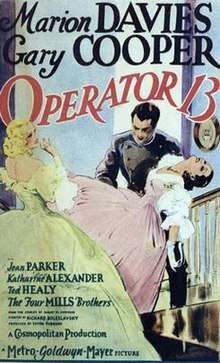Operator 13
| Operator 13 | |
|---|---|
 Theatrical release poster | |
| Directed by | Richard Boleslawski |
| Produced by | Lucien Hubbard |
| Screenplay by |
|
| Story by | Robert W. Chambers |
| Starring | |
| Music by | William Axt |
| Cinematography | George J. Folsey |
| Edited by | Frank Sullivan |
Production company | |
| Distributed by | Metro-Goldwyn-Mayer |
Release date |
|
Running time | 85 minutes |
| Country | United States |
| Language | English |
| Budget | $880,000[1] |
| Box office | $1,010,000[1] |
Operator 13 is a 1934 American romance film directed by Richard Boleslawski and starring Marion Davies, Gary Cooper, and Jean Parker. Based on stories written by Robert W. Chambers, the film is about a Union spy who impersonates a black maid in the early days of the Civil War, but complications arise when she falls in love with a Confederate officer.[2] George J. Folsey received an Academy Award nomination for Best Cinematography.[3]
Plot
In the American Civil War, Union forces are reeling after their defeat in the Second Battle of Bull Run. The Pauline Cushman Players are performing for wounded soldiers at a Union military hospital. Pauline, a spy who works for Allan Pinkerton, recommends her close friend and fellow showgirl Gail to become a spy for the Union cause as Operator 13 (the previous Operator 13 having been caught and shot).
Gail, disguised in blackface, accompanies Pauline south as her octaroon black maid. The Confederates become aware there is a spy in their midst, and Captain Gailliard is asked to help find out who it is. While washing General Stuart’s clothes, Gail hears he will attend a ball that night. At the ball, Captain Gailliard suspects that Pauline is a spy and finds evidence in her room. Pauline, trying to flee, is arrested and is to be a witness against Gail, who is later sentenced to death. Both women manage to escape and return to the Union lines.
Pinkerton decides to use Gail to trap Gailliard, and as part of the plan, she jeers at a parade of Union soldiers and is thought to be a heroine in the Southern newspapers. Gail, as Anne Claibourne, is pardoned by Lincoln and heads south, where Captain Gailliard is attracted to her. However, Gail is later told by Stuart's groom, a fellow spy, that she is known to be a spy and she flees in a Confederate uniform. Gailliard grabs her horse, but she strikes him with a gun and rides off with the groom. Gailliard and others pursue them.
The fugitives hide in an abandoned farmhouse. Gailliard finds her. Fortunately for her, a group of Union soldiers are nearby. When they spot the groom, still wearing a Confederate uniform, they shoot him. Gail and Gailliard watch undetected as a Confederate is executed by a Union firing squad. Gail tells Gailliard she loves him and refuses to betray him to the soldiers. Then the Confederates attack. In the fighting, Gail persuades Gailliard to slip away in the confusion and rejoin his side.
The war effectively comes to an end when Robert E. Lee surrenders to Ulysses S. Grant at Appomattox Court House. Afterward, Gail and Gailliard reconcile.
Cast
- Marion Davies as Gail Loveless (Operator 13)
- Gary Cooper as Captain Jack Gailliard
- Jean Parker as Eleanor Shackleford
- Katharine Alexander as Pauline Cushman (Operator 27)
- Ted Healy as Doctor Hitchcock
- Russell Hardie as Lieutenant Gus Littledale
- Henry Wadsworth as Captain John Pelham
- Douglass Dumbrille as General Stuart
- Willard Robertson as Captain Cornelius Channing
- Fuzzy Knight as Private Sweeney (Stuart’s groom)
- Sidney Toler as Major Allan Pinkerton
- Robert McWade as Colonel Sharpe
- Marjorie Gateson as Mrs Shackleford
- Wade Boteler as Officer Gaston
- Walter Long as Operator 55
- E. Alyn Warren as General Ulysses S. Grant (uncredited)
- Samuel S. Hinds as Officer Price (uncredited)
- Sterling Holloway as Wounded Union soldier (uncredited)
Curly Howard of Three Stooges fame was cast in a small speaking part, which was mostly cut prior to release. He is briefly seen in the film.
Reception
The New York Times reviewer found it "scarcely credible in most of its action", but "In its own peculiar fashion it is entertaining and besides the capable work of Miss Davies there are splendid performances by Jean Parker and Gary Cooper."[2]
The film grossed a total (domestic and foreign) of $1,010,000: $619,000 from the US and Canada and $391,000 elsewhere, resulting in a loss of $226,000.[1]
In Popular Culture
Operator 13 is referenced in the 1935 Three Stooges short film Uncivil Warriors, which lends not only the plot but also the names of the characters (Operators 12 through 15, with Operator 13 having died beforehand).
References
- 1 2 3 The Eddie Mannix Ledger, Los Angeles: Margaret Herrick Library, Center for Motion Picture Study .
- 1 2 M. H. (June 23, 1934). "Civil War Spies". The New York Times. Retrieved July 31, 2016.
- ↑ "The 7th Academy Awards: 1935". Academy of Motion Picture Arts and Sciences.
External links
- Operator 13 on IMDb
- Operator 13 at the TCM Movie Database
- Operator 13 at AllMovie